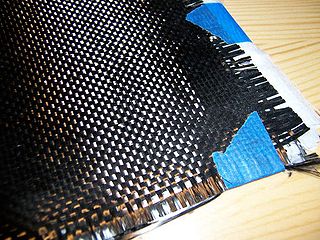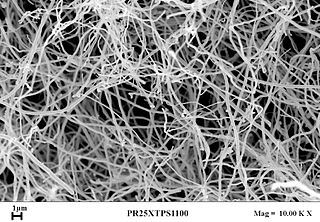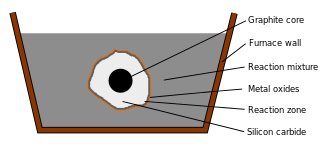
Graphite, archaically referred to as plumbago, is a crystalline form of the element carbon with its atoms arranged in a hexagonal structure. It occurs naturally in this form and is the most stable form of carbon under standard conditions. Under high pressures and temperatures it converts to diamond. Graphite is used in pencils and lubricants. It is a good conductor of heat and electricity. Its high conductivity makes it useful in electronic products such as electrodes, batteries, and solar panels.

Cast iron is a group of iron–carbon alloys with a carbon content more than 2%. Its usefulness derives from its relatively low melting temperature. The alloy constituents affect its color when fractured: white cast iron has carbide impurities which allow cracks to pass straight through, grey cast iron has graphite flakes which deflect a passing crack and initiate countless new cracks as the material breaks, and ductile cast iron has spherical graphite "nodules" which stop the crack from further progressing.

Carbon fibers or carbon fibres are fibers about 5 to 10 micrometers (0.00020–0.00039 in) in diameter and composed mostly of carbon atoms. Carbon fibers have several advantages: high stiffness, high tensile strength, high strength to weight ratio, high chemical resistance, high-temperature tolerance, and low thermal expansion. These properties have made carbon fiber very popular in aerospace, civil engineering, military, motorsports, and other competition sports. However, they are relatively expensive compared to similar fibers, such as glass fiber, basalt fibers, or plastic fibers.

Union Carbide Corporation is an American chemical corporation wholly owned by Dow Chemical Company. It currently employs more than 2,400 people. Union Carbide produces chemicals and polymers that undergo one or more further conversions by customers before reaching consumers. Some are high-volume commodities and others are specialty products meeting the needs of smaller markets. Markets served include paints and coatings, packaging, wire and cable, household products, personal care, pharmaceuticals, automotive, textiles, agriculture, and oil and gas. The company is a former component of the Dow Jones Industrial Average.

Carbon fibre reinforced carbon (CFRC), carbon–carbon (C/C), or reinforced carbon–carbon (RCC) is a composite material consisting of carbon fiber reinforcement in a matrix of graphite. It was developed for the reentry vehicles of intercontinental ballistic missiles, and is most widely known as the material for the nose cone and wing leading edges of the Space Shuttle orbiter. Carbon-carbon brake discs and brake pads have been the standard component of the brake systems of Formula One racing cars since the late 1970’s; the first year carbon brakes were seen on a Formula One car was 1976.

Eveready Industries India Ltd. (EIIL), formerly Union Carbide India Limited, is the flagship company of the B. M. Khaitan Group. The Eveready brand has been present in India since 1905. EIIL's principal activities are the manufacture and market of batteries, flashlight cases, electrolytic manganese dioxide and arc carbons. It also manufactures photo-engravers plates/strips for printing, castings, hard facing and tube rods, carbon electrodes and other related products.

Carbon nanofibers (CNFs), vapor grown carbon fibers (VGCFs), or vapor grown carbon nanofibers (VGCNFs) are cylindrical nanostructures with graphene layers arranged as stacked cones, cups or plates. Carbon nanofibers with graphene layers wrapped into perfect cylinders are called carbon nanotubes.

SGL Carbon SE is a European company based in Germany. It is one of the world's leading manufacturers of products from carbon.
The National Carbon Company was founded in 1886 by the former Brush Electric Company executive W. H. Lawrence, in association with Myron T. Herrick, James Parmelee, and Webb Hayes, son of U.S. President Rutherford B. Hayes, in Cleveland, Ohio. In 1890, National Carbon merged with Thomson-Houston, Standard Carbon, and Faraday Carbon.
Mohnish Pabrai is an Indian-American businessman, investor, and philanthropist. He was born in Bombay (Mumbai), India, on June 12 1964.
A conductive textile is a fabric which can conduct electricity. Conductive textiles can be made with metal strands woven into the construction of the textile or by conductive yarns which are conductive thanks to a metal-coating. There is also an interest in semiconducting textiles, made by impregnating normal textiles with carbon- or metal-based powders.
Carbide-derived carbon (CDC), also known as tunable nanoporous carbon, is the common term for carbon materials derived from carbide precursors, such as binary (e.g. SiC, TiC), or ternary carbides, also known as MAX phases (e.g., Ti2AlC, Ti3SiC2). CDCs have also been derived from polymer-derived ceramics such as Si-O-C or Ti-C, and carbonitrides, such as Si-N-C. CDCs can occur in various structures, ranging from amorphous to crystalline carbon, from sp2- to sp3-bonded, and from highly porous to fully dense. Among others, the following carbon structures have been derived from carbide precursors: micro- and mesoporous carbon, amorphous carbon, carbon nanotubes, onion-like carbon, nanocrystalline diamond, graphene, and graphite. Among carbon materials, microporous CDCs exhibit some of the highest reported specific surface areas (up to more than 3000 m2/g). By varying the type of the precursor and the CDC synthesis conditions, microporous and mesoporous structures with controllable average pore size and pore size distributions can be produced. Depending on the precursor and the synthesis conditions, the average pore size control can be applied at sub-Angstrom accuracy. This ability to precisely tune the size and shapes of pores makes CDCs attractive for selective sorption and storage of liquids and gases (e.g., hydrogen, methane, CO2) and the high electric conductivity and electrochemical stability allows these structures to be effectively implemented in electrical energy storage and capacitive water desalinization.

Tokai Carbon Co., Ltd. is a Japanese company. The company is a developer and stockist of graphite material for use in nuclear power, particularly electrical discharge machining electrode, high temperature, and mechanical applications.
The Boulton Carbon Company was a manufacturing company located in Cleveland, Ohio, USA, from 1881 to 1886. It was devoted to the manufacture of carbon points used for arc lighting. The company was organized in 1881 by W. H. Boulton and Willis U. Masters and formally incorporated in 1883. A controlling interest in the company was acquired in 1886 by a group of investors led by Washington H. Lawrence. In 1886, Lawrence reorganized the Boulton Carbon Company as the National Carbon Company. Under the leadership of Lawrence, the National Carbon Company became the dominate carbon company in the United States and was one of the founding members of the Union Carbide & Carbon Company in 1917.

The Acheson process was invented by Edward Goodrich Acheson to synthesize silicon carbide (SiC) and graphite.
A dual carbon battery is one that uses carbon for both the cathode and the anode.
Silicon carbide fibers are fibers ranging from 5 to 150 micrometres in diameter and composed primarily of silicon carbide molecules. Depending on manufacturing process, they may have some excess silicon or carbon, or have a small amount of oxygen. Relative to organic fibers and some ceramic fibers, silicon carbide fibers have high stiffness, high tensile strength, low weight, high chemical resistance, high temperature tolerance and low thermal expansion. (refs) These properties have made silicon carbide fiber the choice for hot section components in the next generation of gas turbines, e.g. the LEAP engine from GE.
A conductive agent is used to ensure the electrode has good charge and discharge performance. Usually, a certain amount of conductive material is added during the production of the pole piece, and the micro current is collected between the active material and the current collector to reduce the micro current. The contact resistance of the electrode accelerates the rate of movement of electrons, and at the same time, can effectively increase the migration rate of lithium ions in the electrode material, thereby improving the charge and discharge efficiency of the electrode. The conductive agent carbon black is used for improving the conductivity of the electrodes and decreasing the resistance of interaction.
Hard carbon is a solid form of carbon that cannot be converted to graphite by heat-treatment, even at temperatures as high as 3000 °C. It is also known as char, or non-graphitizing carbon. More colloquially it can be described as charcoal.
The piezoelectrochemical transducer effect (PECT) is a coupling between the electrochemical potential and the mechanical strain in ion-insertion-based electrode materials. It is similar to the piezoelectric effect – with both exhibiting a voltage-strain coupling - although the PECT effect relies on movement of ions within a material microstructure, rather than charge accumulation from the polarization of electric dipole moments.









